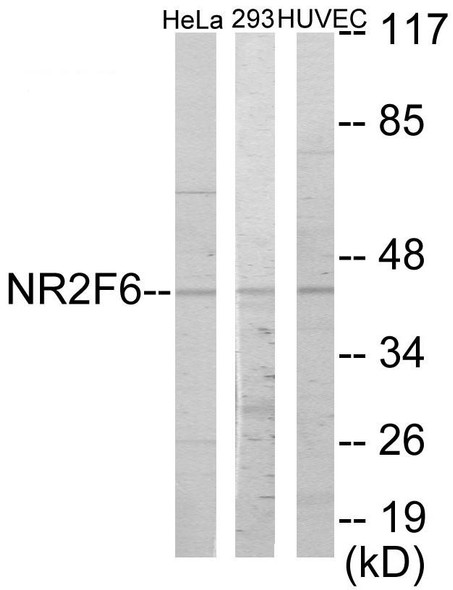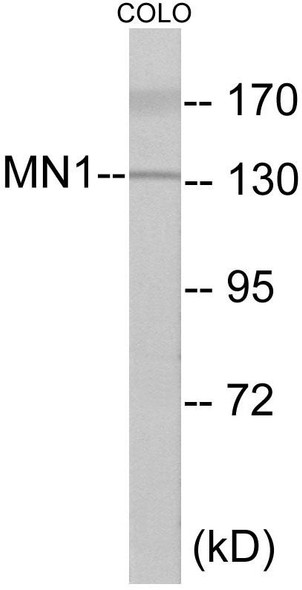Description
ETV6 Colorimetric Cell-Based ELISA
The ETV6 (TEL) Colorimetric Cell-Based ELISA Kit is a cutting-edge tool designed for the precise and efficient detection of ETV6 levels in cell lysates and tissue extracts. This innovative kit offers superior sensitivity and specificity, ensuring accurate and reproducible results for a variety of research applications.ETV6, also known as TEL, is a key transcription factor involved in a variety of cellular processes, including cell differentiation, proliferation, and survival. Dysregulation of ETV6 has been implicated in numerous diseases, such as leukemia, solid tumors, and developmental disorders, making it a critical target for research and potential therapeutic interventions.
With its advanced technology and reliable performance, the ETV6 Colorimetric Cell-Based ELISA Kit is an essential tool for investigating the role of ETV6 in disease pathogenesis and for developing novel treatment strategies. Trust in this kit to deliver accurate and insightful data for your research needs.
| Product Name: | ETV6 Colorimetric Cell-Based ELISA |
| Product Code: | CBCAB01009 |
| ELISA Type: | Cell-Based |
| Target: | ETV6 |
| Reactivity: | Human, Mouse, Rat |
| Dynamic Range: | > 5000 Cells |
| Detection Method: | Colorimetric 450 nmStorage/Stability:4°C/6 Months |
| Format: | 96-Well Microplate |
The ETV6 Colorimetric Cell-Based ELISA Kit is a convenient, lysate-free, high throughput and sensitive assay kit that can detect ETV6 protein expression profile in cells. The kit can be used for measuring the relative amounts of ETV6 in cultured cells as well as screening for the effects that various treatments, inhibitors (ie siRNA or chemicals), or activators have on ETV6.
Qualitative determination of ETV6 concentration is achieved by an indirect ELISA format. In essence, ETV6 is captured by ETV6-specific primary antibodies while the HRP-conjugated secondary antibodies bind the Fc region of the primary antibody. Through this binding, the HRP enzyme conjugated to the secondary antibody can catalyze a colorimetric reaction upon substrate addition. Due to the qualitative nature of the Cell-Based ELISA, multiple normalization methods are needed:
| 1. | A monoclonal antibody specific for human GAPDH is included to serve as an internal positive control in normalizing the target absorbance values. |
| 2. | Following the colorimetric measurement of HRP activity via substrate addition, the Crystal Violet whole-cell staining method may be used to determine cell density. After staining, the results can be analysed by normalizing the absorbance values to cell amounts, by which the plating difference can be adjusted. |
| Database Information: | Gene ID: 2120, UniProt ID: P41212, OMIM: 600618, Unigene: Hs.504765 |
| Gene Symbol: | ETV6 |
| Sub Type: | None |
| UniProt Protein Function: | Tel: Transcriptional repressor; binds to the DNA sequence 5'- CCGGAAGT-3'. A chromosomal aberration involving ETV6 is found in a form of chronic myelomonocytic leukemia (CMML). Translocation t(5;12)(q33;p13) with PDGFRB. It is characterized by abnormal clonal myeloid proliferation and by progression to acute myelogenous leukemia (AML). Chromosomal aberrations involving ETV6 are found in a form of acute myeloid leukemia (AML). Translocation t(12;22)(p13;q11) with MN1; translocation t(4;12)(q12;p13) with CHIC2. Chromosomal aberrations involving ETV6 are found in childhood acute lymphoblastic leukemia (ALL). Translocations t(12;21)(p12;q22) and t(12;21)(p13;q22) with RUNX1/AML1. A chromosomal aberration involving ETV6 is found in a form of pre-B acute myeloid leukemia. Translocation t(9;12)(p24;p13) with JAK2. A chromosomal aberration involving ETV6 is found in myelodysplastic syndrome (MDS) with basophilia. Translocation t(5;12)(q31;p13) with ACSL6. A chromosomal aberration involving ETV6 is found in acute eosinophilic leukemia (AEL). Translocation t(5;12)(q31;p13) with ACSL6. A chromosomal aberration involving ETV6 is found in myelodysplastic syndrome (MDS). Translocation t(1;12)(p36.1;p13) with MDS2. Defects in ETV6 are a cause of myeloproliferative disorder chronic with eosinophilia (MPE). A hematologic disorder characterized by malignant eosinophils proliferation. A chromosomal aberration involving ETV6 is found in many instances of myeloproliferative disorder chronic with eosinophilia. Translocation t(5;12) with PDGFRB on chromosome 5 creating an ETV6-PDGFRB fusion protein. Defects in ETV6 are a cause of acute myelogenous leukemia (AML). AML is a malignant disease in which hematopoietic precursors are arrested in an early stage of development. A chromosomal aberration involving ETV6 is found in acute lymphoblastic leukemia. Translocation t(9;12)(p13;p13) with PAX5. Belongs to the ETS family. |
| UniProt Protein Details: | Protein type:Transcription factor; Oncoprotein; Motility/polarity/chemotaxis; DNA-binding Chromosomal Location of Human Ortholog: 12p13 Cellular Component: cytoplasm; nucleolus; nucleus Molecular Function:protein binding; protein domain specific binding; transcription factor activity Biological Process: cell differentiation; negative regulation of transcription from RNA polymerase II promoter Disease: Thrombocytopenia 5 |
| NCBI Summary: | This gene encodes an ETS family transcription factor. The product of this gene contains two functional domains: a N-terminal pointed (PNT) domain that is involved in protein-protein interactions with itself and other proteins, and a C-terminal DNA-binding domain. Gene knockout studies in mice suggest that it is required for hematopoiesis and maintenance of the developing vascular network. This gene is known to be involved in a large number of chromosomal rearrangements associated with leukemia and congenital fibrosarcoma. [provided by RefSeq, Sep 2008] |
| UniProt Code: | P41212 |
| NCBI GenInfo Identifier: | 730927 |
| NCBI Gene ID: | 2120 |
| NCBI Accession: | P41212.1 |
| UniProt Secondary Accession: | P41212,Q9UMF6, Q9UMF7, Q9UMG0, A3QVP6, A8K076, |
| UniProt Related Accession: | P41212 |
| Molecular Weight: | 53,000 Da |
| NCBI Full Name: | Transcription factor ETV6 |
| NCBI Synonym Full Names: | ETS variant 6 |
| NCBI Official Symbol: | ETV6 |
| NCBI Official Synonym Symbols: | TEL; THC5; TEL/ABL |
| NCBI Protein Information: | transcription factor ETV6 |
| UniProt Protein Name: | Transcription factor ETV6 |
| UniProt Synonym Protein Names: | ETS translocation variant 6; ETS-related protein Tel1; Tel |
| Protein Family: | Transcription factor |
| UniProt Gene Name: | ETV6 |
| UniProt Entry Name: | ETV6_HUMAN |
| Component | Quantity |
| 96-Well Cell Culture Clear-Bottom Microplate | 2 plates |
| 10X TBS | 24 mL |
| Quenching Buffer | 24 mL |
| Blocking Buffer | 50 mL |
| 15X Wash Buffer | 50 mL |
| Primary Antibody Diluent | 12 mL |
| 100x Anti-Phospho Target Antibody | 60 µL |
| 100x Anti-Target Antibody | 60 µL |
| Anti-GAPDH Antibody | 60 µL |
| HRP-Conjugated Anti-Rabbit IgG Antibody | 12 mL |
| HRP-Conjugated Anti-Mouse IgG Antibody | 12 mL |
| SDS Solution | 12 mL |
| Stop Solution | 24 mL |
| Ready-to-Use Substrate | 12 mL |
| Crystal Violet Solution | 12 mL |
| Adhesive Plate Seals | 2 seals |
The following materials and/or equipment are NOT provided in this kit but are necessary to successfully conduct the experiment:
- Microplate reader able to measure absorbance at 450 nm and/or 595 nm for Crystal Violet Cell Staining (Optional)
- Micropipettes with capability of measuring volumes ranging from 1 µL to 1 ml
- 37% formaldehyde (Sigma Cat# F-8775) or formaldehyde from other sources
- Squirt bottle, manifold dispenser, multichannel pipette reservoir or automated microplate washer
- Graph paper or computer software capable of generating or displaying logarithmic functions
- Absorbent papers or vacuum aspirator
- Test tubes or microfuge tubes capable of storing ≥1 ml
- Poly-L-Lysine (Sigma Cat# P4832 for suspension cells)
- Orbital shaker (optional)
- Deionized or sterile water
*Note: Protocols are specific to each batch/lot. For the correct instructions please follow the protocol included in your kit.
| Step | Procedure |
| 1. | Seed 200 µL of 20,000 adherent cells in culture medium in each well of a 96-well plate. The plates included in the kit are sterile and treated for cell culture. For suspension cells and loosely attached cells, coat the plates with 100 µL of 10 µg/ml Poly-L-Lysine (not included) to each well of a 96-well plate for 30 minutes at 37°C prior to adding cells. |
| 2. | Incubate the cells for overnight at 37°C, 5% CO2. |
| 3. | Treat the cells as desired. |
| 4. | Remove the cell culture medium and rinse with 200 µL of 1x TBS, twice. |
| 5. | Fix the cells by incubating with 100 µL of Fixing Solution for 20 minutes at room temperature. The 4% formaldehyde is used for adherent cells and 8% formaldehyde is used for suspension cells and loosely attached cells. |
| 6. | Remove the Fixing Solution and wash the plate 3 times with 200 µL 1x Wash Buffer for five minutes each time with gentle shaking on the orbital shaker. The plate can be stored at 4°C for a week. |
| 7. | Add 100 µL of Quenching Buffer and incubate for 20 minutes at room temperature. |
| 8. | Wash the plate 3 times with 1x Wash Buffer for 5 minutes each time. |
| 9. | Add 200 µL of Blocking Buffer and incubate for 1 hour at room temperature. |
| 10. | Wash 3 times with 200 µL of 1x Wash Buffer for 5 minutes each time. |
| 11. | Add 50 µL of 1x primary antibodies (Anti-ETV6 Antibody and/or Anti-GAPDH Antibody) to the corresponding wells, cover with Parafilm and incubate for 16 hours (overnight) at 4°C. If the target expression is known to be high, incubate for 2 hours at room temperature. |
| 12. | Wash 3 times with 200 µL of 1x Wash Buffer for 5 minutes each time. |
| 13. | Add 50 µL of 1x secondary antibodies (HRP-Conjugated AntiRabbit IgG Antibody or HRP-Conjugated Anti-Mouse IgG Antibody) to corresponding wells and incubate for 1.5 hours at room temperature. |
| 14. | Wash 3 times with 200 µL of 1x Wash Buffer for 5 minutes each time. |
| 15. | Add 50 µL of Ready-to-Use Substrate to each well and incubate for 30 minutes at room temperature in the dark. |
| 16. | Add 50 µL of Stop Solution to each well and read OD at 450 nm immediately using the microplate reader. |
(Additional Crystal Violet staining may be performed if desired – details of this may be found in the kit technical manual.)






